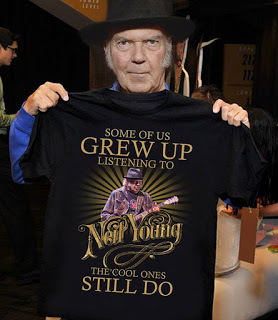Marty Halpern's Blog, page 7
February 4, 2019
January 31, 2019
Listening to Neil Young....
Published on January 31, 2019 14:01
January 18, 2019
Michael Bloomfield - If You Love These Blues: An Oral History by Jan Mark Wolkin and Bill Keenom
"Michael Bloomfield was so much more than a great guitarist. Raconteur, musicologist, renaissance man, mensch, painter, ultimate appreciator are some of the words used to describe him. I've heard it said often that if you knew Michael, you were changed by him, and that when he walked into a room, his charisma and energy made it difficult to focus on much else."
–Bill Keenom
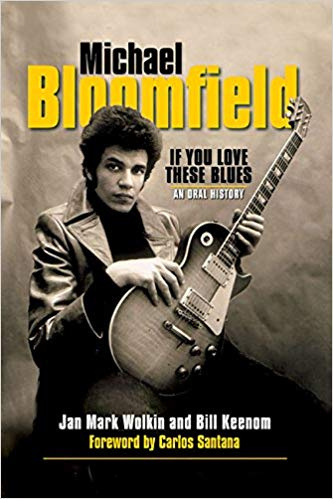 Last summer I read a book entitled Michael Bloomfield: The Rise and Fall of an American Guitar Hero by Ed Ward, and wrote about it briefly in a blog post dated July 10, 2018. I've been a fan of Bloomfield's music for decades, and after reading this book, I knew I needed to read more.
Last summer I read a book entitled Michael Bloomfield: The Rise and Fall of an American Guitar Hero by Ed Ward, and wrote about it briefly in a blog post dated July 10, 2018. I've been a fan of Bloomfield's music for decades, and after reading this book, I knew I needed to read more.The search took me a while, but eventually I tracked down a copy of Michael Bloomfield - If You Love These Blues: An Oral History [image error] by Jan Mark Wolkin and Bill Keenum. My hardcover copy was missing the compact disc that is supposed to accompany the book. The paperback edition doesn't have a CD, but the publisher, Hal Leonard, provides a URL on the back cover so that the reader can access the music online. One problem: The URL is not valid. I've written to the publisher about this, but so far, a week later, I have not received any response.
The subtitle of this book is "An Oral History": the entire book consists of excerpts from interviews with Bloomfield's bandmates, producers and promoters, roommates and friends, and family (including his ex-wife). And, of course, the guitarist himself. The majority of these interviews were conducted by the book's authors, but some, as in the case of Bloomfield, were from prior interviews as the book was published in 2000, and Michael passed away in 1981. But what makes this book unique is that the interview excerpts are provided in chronological order, with excerpts from two or more individuals regarding specific events so that the reader can experience this from multiple viewpoints.
I just counted the markers -- nearly 20 of them -- I placed on various pages in the book denoting quotes that just had to be shared when I wrote this post. Obviously, far too many, but I'll see what I can do about narrowing them down to a very important few.
"When I came back through Chicago in '62, [Michael] took me down to the South Side to hear some music. He said, 'Man, you've got to meet Muddy.' So we go to Pepper's Lounge, and Michael walked right up to the bandstand and said, 'Hey, Muddy.' Muddy says, 'Hey, Michael, how're you doing?' And Michael says, 'I'd like you to meet my friend John Hammond.' I felt like I was going to fall down. And then, in the middle of Muddy's show, he calls Michael up to play with him. I was mind-boggled. And Michael was great. He knew all the details of cool stuff. He was a wonderful guy. I valued his friendship more than I can ever say. He was just a terrific person."–John Hammond Jr.
"...There were other musicians, but Michael was the first one that I befriended and who befriended me. He was a Chicago guy, I'm a New Yorker, and we hit it off, personality-wise. Michael was quick and very witty. And we were able to jabber on easily....[Michael] always had somebody that he was pushing. It if wasn't the Staple Singers, it was Albert King or B.B. King or Otis Redding or Howlin' Wolf. He, more than any single musician, kept bringing me records and mentioning groups to me. Prior to 1965, I knew nothing. I wasn't in the rock & roll world. It wasn't part of my private life. I'm a Latin music fan, a jazz fan of sorts, but I never listened to blues much or rock & roll at all. I think the music industry owes Michael far more than they realize. Besides being a very special musician in what he brought out of the guitar and how he made people feel. I don't know if I would have been that successful early on if it wasn't for Michael, his knowledge and his awareness and his prodding me to bring these artists to the Bay Area. So, as great a guitar player as Michael was, he was really a teacher."–Bill Graham
"When Michael first came to San Francisco, for some reason, he befriended me. I had just started to play with the Jefferson Airplane, and I'd never played electric guitar before, really. He showed me how to bend notes, and to feedback and sustain things, and I was really thrilled. Because in those days some of the East Coast guitar players were very guarded about their secrets and the way they did stuff. I knew guys who used to turn away from you when they played so you couldn't see how they were doing it. Michael was a really sweet guy and a brilliant guitar player, and he was really instrumental in getting me into being an electric guitar player."–Jorma Kaukonen
"Around December 1968, Michael and Nick Gravenites helped Janis Joplin set up the Kozmic Blues Band. Janis had left Big Brother. She was very frightened about what she was going to do about putting a band together....They came in, and Michael took the time to make everyone feel good, and they whipped that band together really quick. He was kind of like an A&R man. He selected the tunes—a lot of them were Nick's—and then he went on and made sure everyone could play them. We had other music directors who were really unessential. Michael was really the one who put it together. Michael played on a few of the Kozmic Blues tracks. I still get people come up to me, if they're real sharp, young guitar players, and they'll say, 'Was that you playing on "One Good Man"?' I'll say, 'No, that was Michael,' and they'll go, 'I knew it! I knew it!'"–Sam Andrew
"When I was 17, I thought I was good enough to gig in black places and hold my own. You had to hold your own. If you shucked, then you had no business being there. You'd not only be a white kid, you'd be a fool. You'd be a punk and a fool....Several guys took me to be almost like I was their son—Big Joe Williams, Sunnyland Slim, and Otis Spann. They took me to be like their kid, man; they just showed me from the heart. They took me aside and said, 'You can play, man. Don't be shy. Get up there and play.' What I learned from them was invaluable. A way of life, a way of thinking, a whole kind of thing—invaluable things to learn. I used to hear Elmore James, Sonny Boy, Little Walter, Howlin' Wolf, Muddy Waters, Freddie King, Albert King—way before they were known anywhere but the ghetto....I was interested in it from a musicological standpoint. I was trying to discover where the old blues singers lived. I met cats like Washboard Sam and Jazz Gillum and Tommy McClennan and Kokomo Arnold. I used to have a band with Big Joe Williams....By then it was a scholarly thing. Like Paul Oliver and Sam Charters, I wanted to know the story of the blues, and the best way for me to learn was to actually meet the guys."–Michael Bloomfield
"In 1969, I produced the Fathers and Sons album. We brought in all these great players: Muddy Waters, Otis Spann, and this great band—all in the Chess studio. I had Michael, Paul Butterfield, Buddy Miles, Duck Dunn, Sam Lay, and every blues musician in Chicago. Michael named it. He said it should be called Fathers and Sons, because that's how he related to Otis Spann and Muddy. He gave me that title, and he insisted that that's what it be."–Norman Dayron
In my previous Bloomfield blog post, I state that the guitarist died alone in his car from an apparent cocaine and methamphetamine overdose: two drugs that Michael would never touch. So the question remained: Why?
In this book, through interviews with Christie Svane, Michael's girlfriend at the time of his passing, I learned what may have driven the guitarist further into the darker realms of loneliness and despair. And Norman Dayron speculates as to why cocaine was found in Michael's system after his death, a drug that Norman knew Michael absolutely refused to use. Again, it's all speculation, but indeed quite plausible.
Michael Bloomfield - If You Love These Blues: An Oral History [image error] by Jan Mark Wolkin and Bill Keenum (Miller Freeman Books, 2000, 280 pages).

Published on January 18, 2019 15:46
January 14, 2019
January 2, 2019
Book Received: That Thin, Wild Mercury Sound by Daryl Sanders
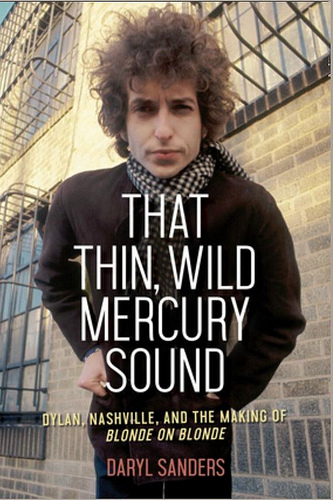 So I asked for, and received, a copy of Daryl Sanders's recently published tome,
That Thin, Wild Mercury Sound
[image error] (Chicago Review Press, October 2018), from my daughter and son-in-law for Christmas. (I learned years ago that one needs to provide a Christmas "wish list" to family, otherwise one ends up with questionable -- and often impractical -- tchotchkes as gifts. This way, one always gets what one wants! So, a huge "thank you" to my family!)
So I asked for, and received, a copy of Daryl Sanders's recently published tome,
That Thin, Wild Mercury Sound
[image error] (Chicago Review Press, October 2018), from my daughter and son-in-law for Christmas. (I learned years ago that one needs to provide a Christmas "wish list" to family, otherwise one ends up with questionable -- and often impractical -- tchotchkes as gifts. This way, one always gets what one wants! So, a huge "thank you" to my family!)The book's subtitle: "Dylan, Nashville, and the Making of Blonde on Blonde" sums up exactly what this book is about. Blonde on Blonde was Bob Dylan's seventh studio album, released on June 20, 1966 -- and holds the distinction as the first rock double-album.
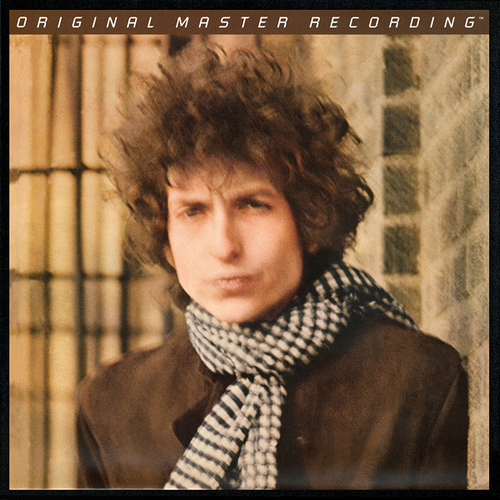
To accompany my reading of this book, I had previously purchased a copy of the limited release of Mobile Fidelity's Original Master Recording of Blonde on Blonde [image error]: a stunning three-LP box set mastered at 45 RPM. This LP release is no longer available (except on the secondary market), but the Super Audio CD (SACD) version is still being sold at retail, and that is the link I've provided.
"Detailed and diligent, Daryl Sanders has played local detective, seemingly digging up every Nashville cat who was in Studio A when Dylan did it his way in 1966, changing country and rock for good."
–Clinton Heylin, author of Trouble in Mind: Bob Dylan's Gospel Years and Bob Dylan: Behind the Shades Revisited
"Major victories like Blonde on Blonde often seem inevitable and easy. But Daryl Sanders has interviewed the survivors, noted the casualties, and pondered the battlefield strategies that conquered a country."
–Daniel Wolff, author of Grown-Up Anger: The Connected Mysteries of Bob Dylan, Woody Guthrie, and the Calumet Massacre of 1913

Published on January 02, 2019 14:30
December 23, 2018
"Vinyl Sucks, But I Love It."
"Any REAL audiophile or home theater enthusiast knows the truth...that vinyl sucks. It does. It sucks, but I love it. Here's a fun little video explaining why vinyl sucks and why it still matters."–Andrew Robinson, Tech Writer

Published on December 23, 2018 13:55
December 21, 2018
Book Received: The Labyrinth Index by Charles Stross
[image error]
[image error]
I have received my comp copy of The Labyrinth Index [image error], courtesy of Lauren Hougen, Associate Managing Editor at St. Martin’s Press. It's always a joy to receive an actual physical copy of a book I have worked on, especially this series, which is so near and dear to my heart, going back to WorldCon 60 in 2002, when I first met Charles Stross....
You can read about my work on The Labyrinth Index in my blog post on April 8, 2018.
And if you are new to Stross's Laundry Files series, or haven't picked up a title in a bit, you can catch up with a recap of the series to which I have provided a link in my blog post on November 17, 2018.

I have received my comp copy of The Labyrinth Index [image error], courtesy of Lauren Hougen, Associate Managing Editor at St. Martin’s Press. It's always a joy to receive an actual physical copy of a book I have worked on, especially this series, which is so near and dear to my heart, going back to WorldCon 60 in 2002, when I first met Charles Stross....
You can read about my work on The Labyrinth Index in my blog post on April 8, 2018.
And if you are new to Stross's Laundry Files series, or haven't picked up a title in a bit, you can catch up with a recap of the series to which I have provided a link in my blog post on November 17, 2018.
"Imagine a world where gnarly Lovecraftian demons are all too real yet are routinely neutralized with high-tech wizardry by a supersecret British spy agency, and you'll get an inkling of the genre-bending territory Stross explores in the Laundry Files novels." –Booklist

Published on December 21, 2018 09:56
December 17, 2018
The Timeless Movie on NBC December 20!
"What's the point of saving history if we don't save the people in it?"
–Lucy Preston, Timeless, NBC

–Lucy Preston, Timeless, NBC

Published on December 17, 2018 12:33
December 3, 2018
In Memory of Frank Zappa
Published on December 03, 2018 15:09
November 22, 2018
Got a Revolution! The Turbulent Flight of the Jefferson Airplane by Jeff Tamarkin
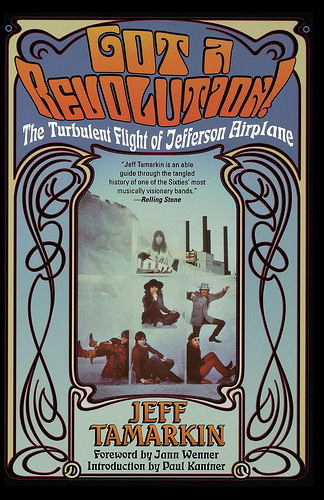 Here's a trivia question for you: Who was Jefferson Airplane's first female singer?
Here's a trivia question for you: Who was Jefferson Airplane's first female singer?So I was reading the recently published (August 2018) autobiography Been So Long: My Life and Music [image error] by Jorma Kaukonen, founding member and lead guitarist of both Jefferson Airplane and Hot Tuna -- and the book was fairly boring, focusing more on Jorma's drug abuse and marriage problems than I would have preferred. So I sought what I hoped would be a much better read and found it in Got a Revolution! [image error] by journalist and music critic Jeff Tamarkin (Atria Books, 2003, 408 pages). The subtitle, "The Turbulent Flight of the Jefferson Airplane," truly sums up the career of this band: in-fighting, relationships, drugs, arrests, etc. -- but unlike the Kaukonen book, the music was always the focus.
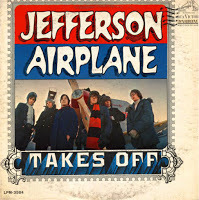
To answer the trivia question above: Signe (pronounced "Sig-nee") Anderson was the first female singer in Jefferson Airplane. She appears on the first Jefferson Airplane album, Takes Off, released in 1966 by RCA Victor (catalog number LPM 3584 (mono) and LSP 3584 (stereo)). However, her husband was having ongoing conflicts with other members of the band, so when Signe became pregnant, she decided to leave the band to raise her family.
The band The Great Society had opened for Jefferson Airplane during many of their concert appearances. The band members included Grace Slick, her husband Jerry Slick, and Jerry's brother Darby Slick. Marty Balin, one of the founding members of the Airplane, was intrigued by Grace's singing and stage presence, so when Signe left the band, Marty asked Grace to join -- and she said yes immediately. (Note: Two of the Great Society's band members had recently left for India to study Indian music, so the band was essentially defunct anyhow.)
Grace brought with her two songs: "Somebody to Love" (written by Darby Slick and originally titled "Someone to Love") and "White Rabbit," written by Grace herself. And the rest, as they say, is history.
Jeff Tamarkin, on the band's recording of their breakout album, Surrealistic Pillow (RCA Victor, LPM-3766/LSP-3766, 1967):
...The next session that day was for the other song Grace imported from the Great Society, "Somebody to Love." With that group, Darby Slick's composition was played almost as a midtempo shuffle. The first change the Airplane made was to virtually double the tempo, cranking it out at a breakneck pace that remains nearly static from verse to chorus. The Airplane version is tightly reined, placing Grace front and center and leaving no slack...The second change was lyrical, a reference to "in bed" being softened to the more radio-friendly "in your head."All told, it's a tour de force performance and, upon its release in early 1967, it would become, along with "White Rabbit," one of the defining recordings of the era.
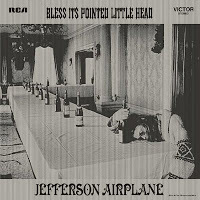 Surrealistic Pillow was a tight, in-your-face, commercial endeavor, which may be difficult to comprehend considering this was the Jefferson Airplane, one of the premier psychedelic San Francisco bands. The average song length on the album was approximately 3 minutes, with only one song tracking in at just over 5 minutes. Where the band stood out, however, was during their live performances, when Jorma, Jack Cassidy (electric bass), and Spencer Dryden (drums) would get into a groove that could last for 10 or more minutes. This Jefferson Airplane can be heard on their first (and best) live album entitled Bless Its Pointed Little Head (RCA Victor, LSP-4133, 1969).
Surrealistic Pillow was a tight, in-your-face, commercial endeavor, which may be difficult to comprehend considering this was the Jefferson Airplane, one of the premier psychedelic San Francisco bands. The average song length on the album was approximately 3 minutes, with only one song tracking in at just over 5 minutes. Where the band stood out, however, was during their live performances, when Jorma, Jack Cassidy (electric bass), and Spencer Dryden (drums) would get into a groove that could last for 10 or more minutes. This Jefferson Airplane can be heard on their first (and best) live album entitled Bless Its Pointed Little Head (RCA Victor, LSP-4133, 1969).But getting back to the song "White Rabbit"...in the book, Jeff Tamarkin details how Grace Slick wrote the song:
Inspired, Grace sat down to write a new song of her own. Drawing on her love of all things Spanish, she fashioned a snaky bolero rhythm. Then, thinking back on her childhood fantasies, she suggested a correlation between the mystical worlds of those timeless tales and the quests that she and her fellow seekers were undertaking as young adults:
One pill makes you larger and one pill makes you small
And the ones that Mother gives you don't do anything at all
Go ask Alice when she's ten feet tall.
There had never been another song like "White Rabbit." Originally called "White Rabbit Blues," it was Lewis Carroll meets Ravel meets Sketches of Spain [Miles Davis]. Electric guitars and snare drums piled atop one another, blatant drug allusions crossed paths with bedtime stories, all climaxing in a smashing crescendo, a bellowing Grace inventing a catch phrase for her generation, "Feed your head! Feed your head!"
Throughout the book, Tamarkin also covers the side projects -- solo albums, bands, book projects, etc. -- of each of the Airplane members: the original members as well as the band members that followed in each of the band's later incarnations, including Jefferson Starship, Starship, and Hot Tuna. For example, in 1987, Paul Kantner spent time with the Sandinistas in Nicaragua in support of their revolution. He self-published his experiences in Paul Kantner's Nicaragua Diary (Little Dragon Press, 1987, 113 pages). His other band members had refused to journey with him to Nicaragua at the time because they felt it was too dangerous.
And, drummer Spencer Dryden eventually joined up, in 1982, with bassist Peter Albin (Big Brother & The Holding Company), guitarist John Cipollina (Quicksilver Messenger Service), guitarist Barry Melton (Country Joe and the Fish), and keboard player Merl Saunders (Jerry Garcia) to form the band Dinosaurs. Their first self-titled album was released on the Relix Records label (RRLP 2031) in 1988.
"Go ride the music...."

Published on November 22, 2018 11:30


